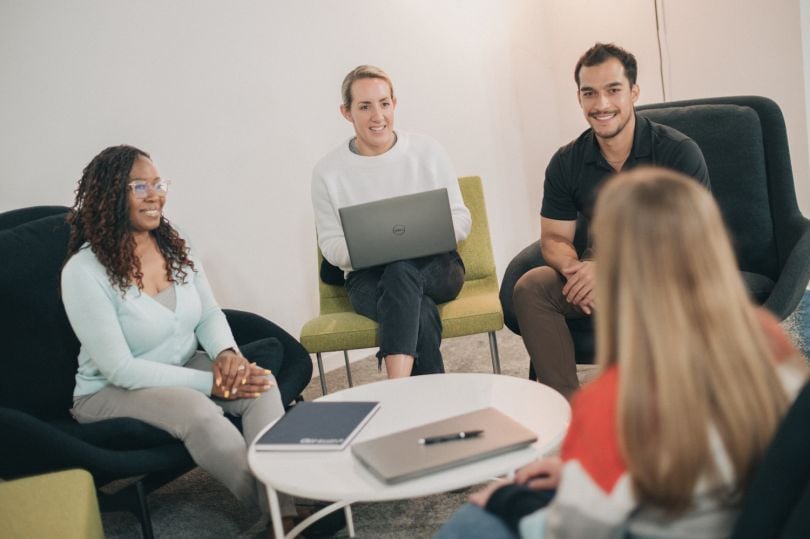When Nagini Indugula walked through her front door after a long day at work, she was immediately greeted by her four-year-old son — who had a very important question.
“Did your rocket launch today?”
“It’s funny because my family literally calls it a spaceship,” said Indugula, vice president of product at GoHealth, a healthtech company that helps Medicare consumers find a plan that fits their budget and health needs.
Before a big demo or important presentation, Indugula will walk through a practice round at home. “Even my four-year-old knows what I’m working on,” she said, laughing.
The big launch that Indugula practiced so fervently for is called the GoHealth Consumer Marketplace — and it’s the first phase of GoHealth’s digital transformation.
“It’s a shift from transactional to relational,” said Indugula. “From a technology and product standpoint, this shift also provides incremental leverage to all inbound consumer channels.”
What Does GoHealth Do?
GoHealth started in 2001 with the goal of helping Americans easily find access to the right health insurance. Within three years, the company developed technology that provided insurance brokers with coverage quotes. Today, GoHealth can be used by insurance agents and directly by enrollees.
Historically, Medicare enrollees would call GoHealth and speak to an agent from the CARES team who would walk them through the insurance plan options that are available and pick the plan that is best for their unique medications, conditions and budget.
Behind the scenes: When a CARES team member would pick up the phone, their first step would be to use a piece of GoHealth’s proprietary machine learning algorithm, called Plan Fit, to recommend which plan would be best. The PlanFit tool would do this with the assistance of a large language model that deciphers the prodigious amount of data about each insurance plan and the nuances within them.
Indulgula’s team is working to cue up that digital platform to step out onto the stage for anyone to see and use — not just insurance brokers or the GoHealth CARES team.
“Our proprietary PlanFit technology has been used behind the scenes by our agents to offer Medicare enrollment support for many years, but recently made its debut with consumers,” Indugula said.
Medicare by the Numbers
- There are 67.2 million people enrolled in Medicare, as of March 2024
-
50.4 percent of people enrolled in Medicare are also enrolled in other health plans, according to the Center for Medicare and Medicaid Services
-
By 2040, roughly 78.3 million Americans will fall within that age group, according to the National Council on Aging
The AI Challenge
While it’s a bit different than launching a rocket into orbit, the technological sophistication of GoHealth’s LLM and user experience further enrich the consumer experience.
Matt Owen, senior data scientist, is overseeing the build of GoHealth’s LLM, and is doing so with a focus on scalability.
“These models will be tailored to our customers and improve our recommendations for which plan they should be on, ultimately helping our agents serve our customers better,” said Owen.
Owen’s team can test GoHealth’s AI in various pockets of the business, all to fine-tune the customer experience.
“We’re able to incubate a lot of these technologies with our agents who are working with live consumers,” said Owen. “So take, for example, something like PlanFit — our agents have been using that for over two years. That’s allowed us to gain quick feedback and improve the model greatly before we launched it.”

He went on to explain how the team has to take vastly different approaches to the data they work with each day.
“There’s definitely a strong delineation between a customer’s personal data and plan data, which is publicly available,” he noted. “And in reality, a lot of consumers are struggling with the public data, right? It’s not presented well to them.”
Indugula noted just how complex it is just to understand the data inside one health insurance plan — each prescription changes price depending on the tier, brand, pharmacy, if it can be mailed, the size of the refill, the form of the medication (tablet, injectable, etc.) … the list goes on, and that’s just for one prescription.
“Some consumers might take 10-plus prescriptions every day, so we really have to break it down for them,” Indugula explained. “And this is just considering prescription drug impacts — then there’s provider costs, hospitalizations … you can’t just build a one-size-fits-all experience.”
The product team has a unique challenge to break down all of the differences between each plan and tailor it to each customer’s specific health needs — something that wouldn’t be possible without an LLM.
“We’re focusing our AI on things like accurate retrieval, concise summarization, and translating complex terms that may exist in a legal document into something that’s easier for the average person to understand, ‘Does my plan cover this?’” added Owen.
Michele Lodl, vice president of consumer experience and lifecycle marketing, is working side by side with Indugula and Owen to observe what a consumer needs during each touchpoint of the shopping and enrollment journey.
“It's really exciting that we have this opportunity to develop a more relationship-based consumer experience,” said Lodl. “We have this awesome opportunity to be the destination that Medicare consumers go to for help and expertise. One of the ways we gather insights to elevate our consumer experience is by building data connections that signal to us the type of help consumers want. Another is by having conversations with consumers about how they wish to interact with technology tools.”
“We have this awesome opportunity to be the destination that Medicare consumers go to for help and expertise.”
Indugula is constantly taking notes on the insights that Lodl’s team can surface.
“It helps us form a better experience,” she noted.
Value Apparent
The values at GoHealth are easy to spot in action throughout the customer journey research, product design process and the development cycle — especially when it comes to AI. Take the act of A/B testing that Owen’s team constantly is doing.
“One of the important approaches in how we use data is just how much we are A/B testing,” noted Owen. “It allows us to get accurate readings of the incremental impacts in our model releases. We can measure a lot of small changes very quickly, because of the scale that we have and how many interactions we’re having.”
The result means that the product team can make two to three changes in their models per sprint.
“We’re able to constantly iterate,” he added. “That framework for continuous improvement allows us to deliver results and innovate quickly, all while operating at scale.”
GoHealth Values
- Integrity
-
Collaboration
-
Accountability
-
Resilience
-
Empathy
The constant A/B testing on Owen’s team is a good example of empathy on behalf of the customer and a commitment to integrity, as the team is determined to always get it right. Together, these two values reflect how seriously the technical teams at GoHealth take their roles, and people’s concerns about their healthcare.
“Touching on empathy and still in the theme of experimentation, there’s a lot of qualitative and subjective discussions that we continue to have with our consumers,” said Indugula. “We are literally co-creating with our consumers.” She explained how, as the product team builds the GoHealth experience, they are constantly placing it in front of customers.
“However, I feel like “resilience” is the strongest core value for the GoHealth team overall,” she added, explaining how working in insurance tech means a lot of their product plans have to pivot at a moment’s notice when new policies are introduced. “I have not seen a more never-give-up type of attitude than I see here.”
‘Creative Conflict’ and Collaboration
One of the most notable parts of speaking with the team at GoHealth is how often all three of them brag — not about their own accomplishments, but about the other people in the room.
All within an hour: Lodl pointed out Owen’s leadership around AI, how the machine learning team spends time researching new developments in the field. Owen spoke to Indugula’s technical guidance on how to make the digital experience mimic the comfort and clarity of a phone call. Indugula cited Lodl’s customer research and segmentation studies as the launching point for numerous projects.
In keeping with the rocket metaphor, these three leaders at GoHealth always seem ready to give a standing ovation for a different part of Mission Control because they are all helping the capsule reach its orbit.

It’s not surprising to see this type of collaboration among team leaders developing something new for their organization. What is notable, though, is that these three leaders seem to both genuinely enjoy working together while also asking each other hard questions — not shying away from what they call ‘creative conflicts.’
Lodl recalled, “During my very first week at GoHealth, Matt said, ‘Let’s meet every week and talk about innovation.’ That was super fun, because it was a fast way for me to learn how the technology works, to understand the experience we already had and ways to build on it.”
For Lodl, that initial invitation set the creative tone of her work at GoHealth.
Owen laughed at the story and added, “We’ve been working together for a long time to reach this point. And not just for this one project; this is the culmination of a lot of different things we’ve been doing over the years.”
As Lodl explained it, “The three of us share a love for learning. It highlights our ability to have creative conflicts. Calling it an ideation actually doesn’t do it justice for how far the three of us will push each other — in a friendly, creative way.”
“The three of us share a love for learning. It highlights our ability to have creative conflicts.”
The three will ask each other questions like, ‘How do we get from A to B?’ or say things like, ‘I think you need to simplify that idea down before we go further.’
“I think that’s actually where the magic happens, when you get three teams who are responsible for various angles of the consumer journey synced on what we’re doing going forward,” said Lodl. “And you don’t get the kind of exciting change we all want to create without a little bit of creative tension underneath that. I think that’s special.”








